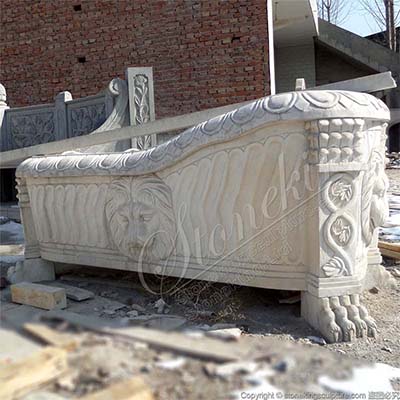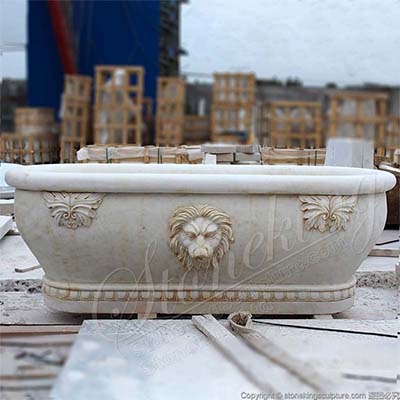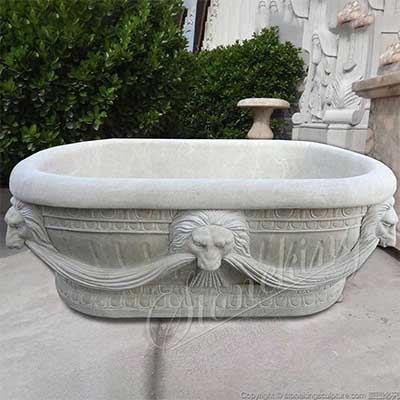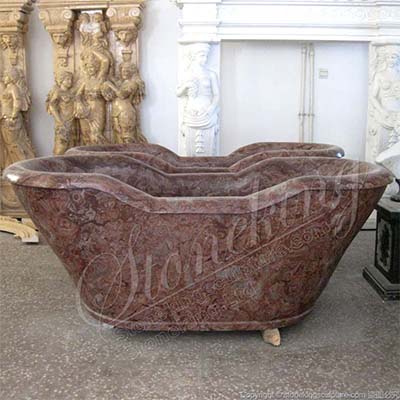Factory Supply Natural Marble Stone Bathtub with Clawfoot for Bathroom for sale
Discover the elegance of our natural marble stone bathtub with clawfoot design. Perfect for creating a luxurious spa experience at home, this stunning centerpiece combines timeless beauty with modern comfort, enhancing your bathroom's aesthetic while providing a relaxing escape.
Size: Customized Size
Material: Solid Marble
Usage: Indoor decoration
Advantage: Wholesale price offered
Carved from high quality marble, this freestanding bathtub features unique color with beige and dark red within the natural stone, a distinctive character that enhances that natural beauty and creates and a striking visual appeal. Whether you are designing a modern minimalist bathroom or a vintage-inspired space, the marble bathtub will provide an opulent and luxurious feel.
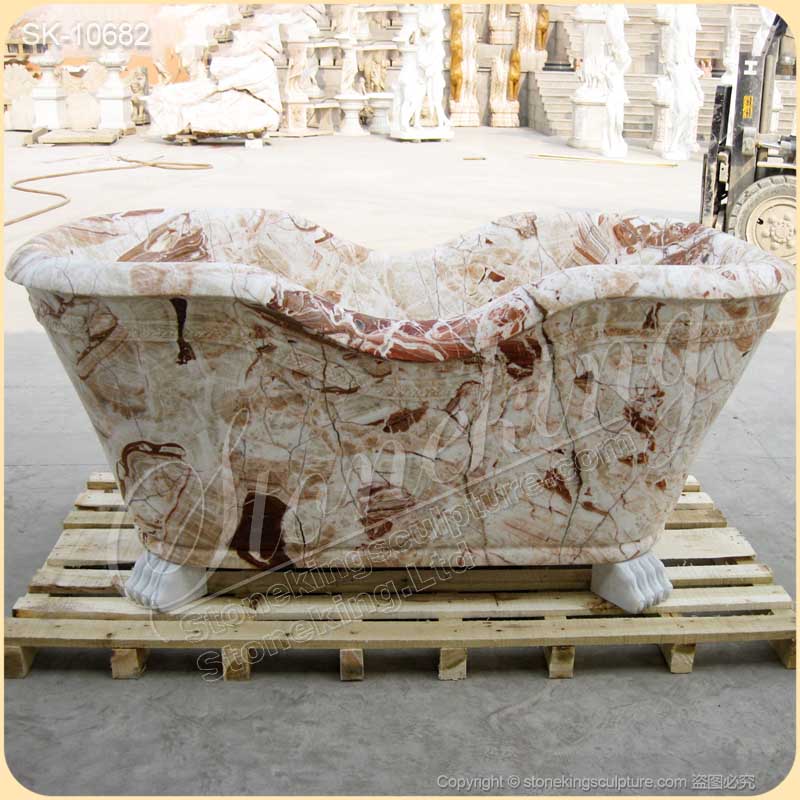
The lion clawfoot design offer a functional and sturdy base, combining vintage charm with modern luxury. The smooth, contoured interior cradles the body, providing optimal comfort during long, relaxing soaks. Marble's heat retention properties ensure that your bath stays warm for longer periods, allowing you to unwind in complete tranquility. Besides, this stone bathtub is designed to last, offering longevity and resistance to wear and tear, and the smooth, polished surface is resistant to stains and scratches, making it easy to clean and maintain. Additionally, the freestanding design provides flexibility in placement, allowing for greater creativity in bathroom layouts.
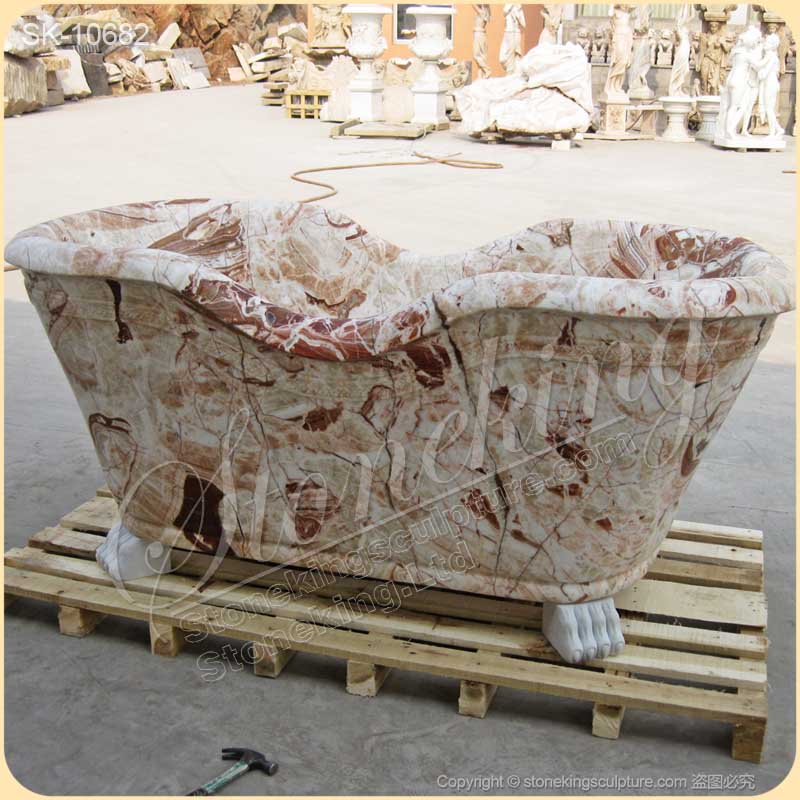
The combination of exquisite design and practical benefits make this marble stone bathtub a worthy investment, providing a relaxing and immersive bathing experience. Perfect for modern or classic settings, this bathtub is a blend of elegance, sophistication and durability that stands the test of time. Contact with us freely to customize the appropriate sizes of the bathtub for you.
Table of Contents
How Much does a Stone Bathtub Cost?
What are the Benefits of a Stone Bathtub?
How to Clean and maintain a Stone Bathtub?
What Types of Stone are Commonly Used for Bathtubs?
Can a Stone Bathtub be Installed in Any Bathroom?
What Styles and Designs are Available for Stone Bathtubs?
Do Stone Bathtubs Retain Heat Better than Other Materials?
Can Stone Bathtubs be Customized?
How do Stone Bathtubs Compare to Other Materials?
Are Stone Bathtubs Environmentally Friendly?
What is a Stone Bathtub?
A stone bathtub is a luxurious, high-end bathtub carved from natural stone materials, such as marble, granite, travertine, limestone, or onyx, offering a unique combination of beauty, durability and sophistication. These bathtubs are designed to provide a unique bathing experience, characterized by their elegant aesthetics and robust construction. They are often handcrafted, resulting in each piece being unique in appearance and feel, making them a focal point of any bathroom design.
Each stone bathtub is carved from a single block of natural stone, making every tub a one-of-a-kind masterpiece. The natural veining, texture and color variations give these bathtubs a unique charm and organic beauty that cannot be replicated by synthetic materials. Stone is an incredibly durable material, resistant to cracks, chips and wear over time, so a stone bathtub is an investment that will last for decades, withstanding daily use without losing its integrity or beauty. They come in a wide variety of shapes and sizes, from classic oval or rectangular designs to more modern, freeform styles.
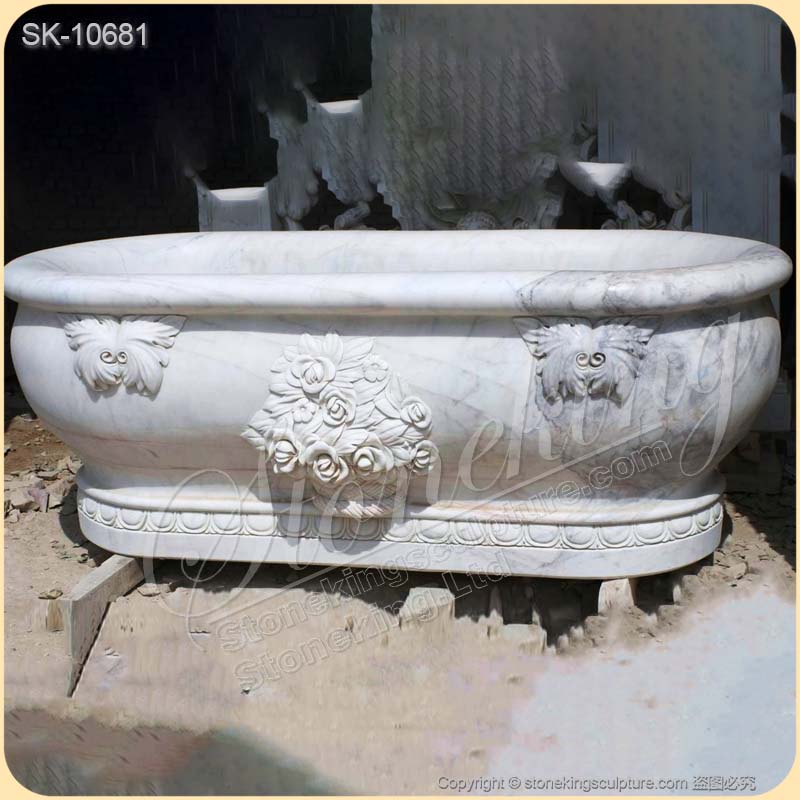
Stone is an excellent material for retaining heat, and the stone bathtub keeps the water warmer for longer periods compared to traditional acrylic or fiberglass tubs. This allows for a more relaxing and enjoyable soak without the need to frequently add hot water, providing a more comfortable and relaxing bathing experience. Stone bathtubs are seen as a luxury item, and they often serve as the centerpiece of the bathroom and create a spa-like atmosphere.
As no two pieces of natural stone are alike, each stone bathtub is a unique work of art. The natural variations in the stone ensure that each bathtub will stand out a s a one-of-a-kind statement piece. Stone bathtubs are often considered environmentally friendly, as they are carved from natural materials without harmful chemicals or synthetic additives. Stone bathtubs are significantly heavier than traditional tubs and require regular care to maintain its beauty. A stone bathtub is an exquisite and durable choice for any bathroom, offering luxury, aesthetics and sense of natural beauty.
Are Stone Bathtubs Good?
Stone bathtubs have become a popular choice for those seeking to create a luxurious and natural aesthetic in their bathrooms. They combine timeless elegance with modern functionality, transforming an ordinary bathroom into a serene, spa-like retreat. Whether made from marble, granite, limestone or onyx, these bathtubs bring a unique charm and character to any bathroom space.
Aesthetic Appeal
Stone bathtubs are visually stunning and celebrated for their innate connection to nature. Each stone tub is unique because no two stones are alike, meaning the patterns, veining and color variations provide an individualized, natural beauty. Stone bathtubs epitomize luxury, and these bathtubs often act as statement pieces in a bathroom, adding elegance and opulence. Stone's organic look complements both contemporary and rustic designs, making it versatile for various bathroom styles.
Durability
Stone is one of the most durable materials for bathtubs. Unlike acrylic or fiberglass, stone is naturally durable and highly resistant to scratches, chips and other forms of wear and tear. They owe this resilience to the natural strength and hardness of stone materials. The natural composition of these stones allows them to withstand frequent use, extreme water temperatures and chemical exposure without deteriorating quickly. Unlike acrylic or fiberglass bathtubs, stone does not crack or discolor over time, making it a long-lasting investment. With proper care, a stone tub can last for decades, maintaining their beauty and functionality over time.
Heat Retention
One of the standout features of stone bathtubs is their ability to retain heat. Stone absorbs and holds warmth longer than traditional materials, allowing people to enjoy longer, more comfortable soaks without constantly replenishing hot water. This makes stone tubs perfect for long, relaxing soaks, enhancing the overall bathing experience.
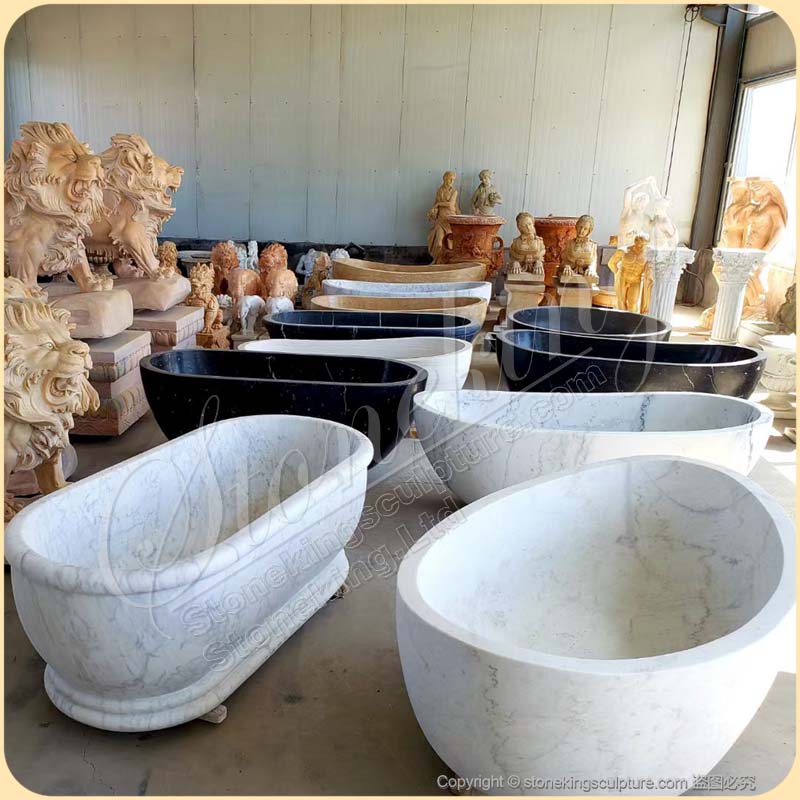
Eco-Friendly Material
Many stone bathtubs are carved from a single block of natural stone, minimizing the use of synthetic chemicals or additives. As stone bathtubs are highly durable and long-lasting, reducing the need for frequent replacements and associated environmental costs of manufacturing new products. As stone is a natural product, meaning it does not typically emit harmful volatile organic compounds into the environment, which occur with plastic or other man-made materials. Stone bathtubs can be repurposed for other uses, reducing landfill waste.
Weight
Stone bathtubs are incredibly heavy. Depending on the types of stone and size of the tub, these tubs can weight several hundred pounds, which represents challenges for installation. Before installing a stone bathtub, it is critical to asses whether the bathroom floor can support such weight. Often, structural reinforcements are required to support the weight, especially in upper-level bathrooms.
Cost
Stone bathtubs are a luxury item, so they are generally more expensive than traditional tubs from acrylic, fiberglass or even cast iron. Creating a stone bathtub involves high levels of craftsmanship, particularly is the tub is hand-carved or customized. Skilled artisans are often required to shape and polish and stone, a labor-intensive process that increases the price. While other materials like acrylic or fiberglass are typically mass-produced using molds, making them faster and cheaper to manufacture.
Maintenance
Natural stone is porous and can absorb water, oils and other substances, which can lead to staining or damage over time if not properly sealed. Regular maintenance, including resealing the tub periodically to prevent moisture damage, mildew growth and staining, is required to keep the stone in top condition and prevent water. Cleaning must be done with care, as harsh chemicals can damage the stone surface. Mild, stone-safe cleaners are recommended to maintain the bathtub's appearance.
Surface Temperature
While stone retains heat once warmed, it can feel quite cold to the touch when first getting in. This may be uncomfortable for some users, especially in colder climates. To counter this, pre-warning the tub with hot water may be necessary.
How Much does a Stone Bathtub Cost?
The cost of a stone bathtub can vary greatly depending on several factors, including the type of stone, size, craftsmanship, quality and design complexity. Stone bathtubs are considered luxury items, and their prices reflect the premium nature of the materials and the work required to shape and install them. So, their prices typically range from USD1000 to USD5000 or more.
Stone bathtubs are available in various materials, and the type of stone is one of the biggest factors influencing the price. Popular options include marble, granite, limestone, travertine and onyx. Marble bathtubs are prized for their natural veining and elegant appearance, granite is durable and resistant to scratches, travertine is a more porous stone, limestone has a soft, warm appearance, and onyx is an exotic stone that can be translucent and strikingly beautiful. Each stone material may have different prices.
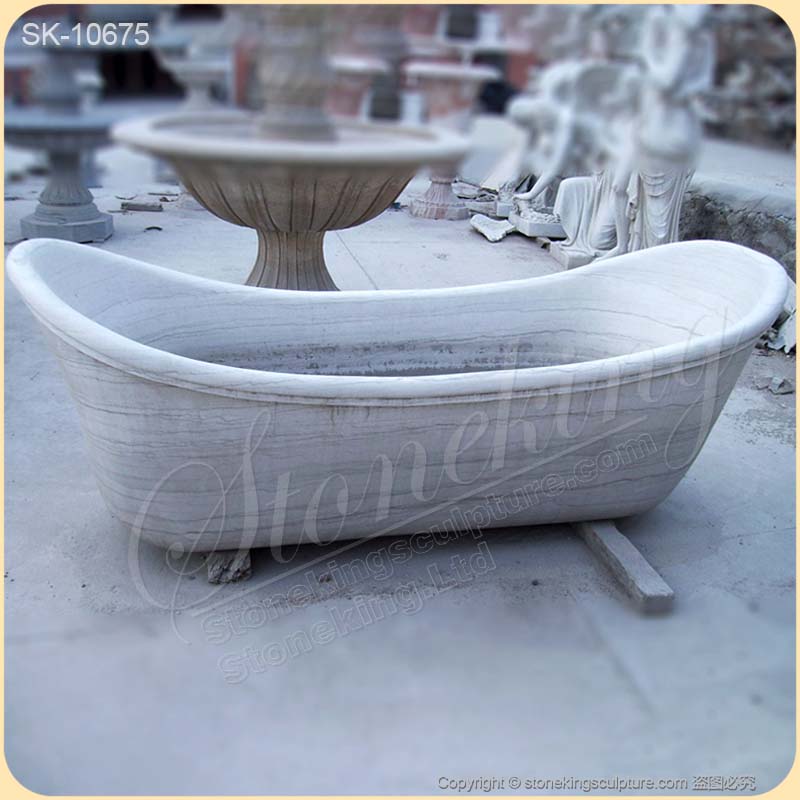
The size and shape of the bathtub also significantly impact the cost. Large bathtubs require more materials and effort to carve, while smaller, compact stone bathtubs are more cheaper. The level of craftsmanship and customization also affects the price. A basic stone bathtub with a simple design may be more affordable, while a custom-carved bathtub with intricate details, special features, or custom engraving will increase the cost.
The installation of a stone bathtub is more complex than a standard tub. These bathtubs are heavy, and special structural support may be needed, so the installation cost should also be considered.
What are the Benefits of a Stone Bathtub?
Stone bathtubs have become a symbol of luxury, elegance and timeless beauty in modern bathrooms. Their natural appearance, texture and uniqueness make them a sought-after choice for those who want to add an element of sophistication to their home.
Aesthetic Appeal
One of the most striking benefits of a stone bathtub is its natural beauty. Available in various types of stone, such as marble, granite and limestone, these tubs offer a elegant and timeless look. The unique patterns and textures of stone can serve as a stunning focal point in any bathroom, elevating the overall design and creating a spa-like atmosphere. They can complement a range of decor styles, from modern minimalism to rust charm, making them a versatile choice for any homeowner.
Durability and Longevity
One of the most significant benefits of stone bathtub is their exceptional durability. Unlike acrylic or fiberglass tubs, stone is resistant to scratches, dents and discoloration. With proper care, a stone bathtub can last for decades, maintaining its beauty and functionality over time. This longevity makes it a worthwhile investment, adding value to your home and reducing the need for frequent replacements.
Natural Heat Retention
Stone has excellent thermal properties, meaning it can retains heat exceptionally well. When filled with hot water, a stone bathtub stays warm longer than traditional materials. This means you can indulge in a luxurious, relaxing soak bath without the constant need to refill hot water. The natural warmth of the stone enhances your bathing experience, providing a spa-lie ambiance right in your home.
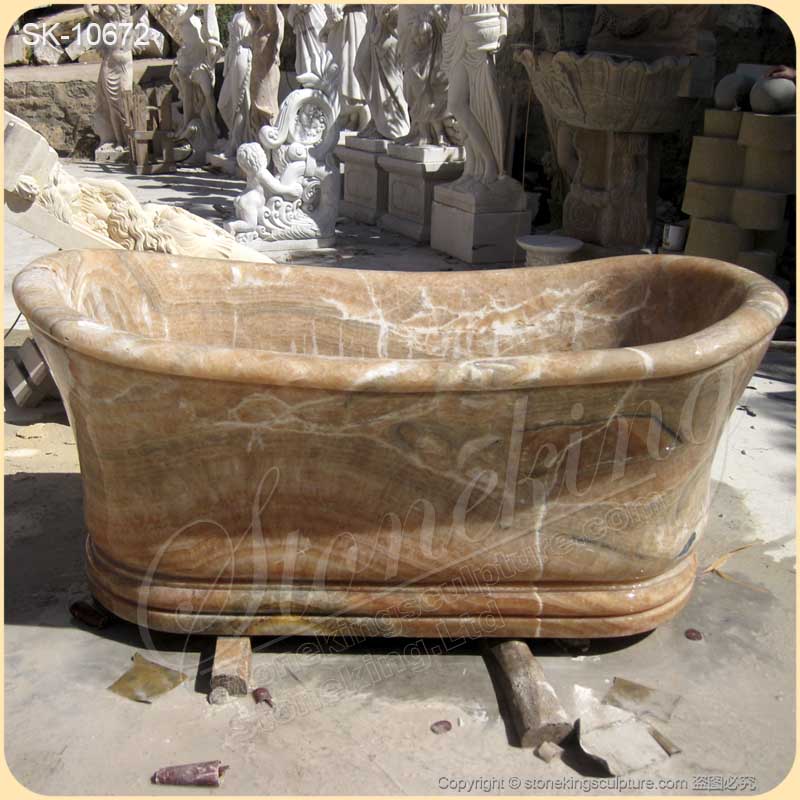
Eco-Friendly Choice
Stone bathtubs are made from natural materials, making them a more eco-friendly choice compared to synthetic options. Stone bathtubs do not release harmful chemicals into the air, promoting a healthier indoor environment. Choosing a stone bathtub can contribute to a more sustainable home environment. Additionally, the natural characteristics of stone provides a unique sensory experience, connecting you with nature while you unwind.
Low Maintenance
While stone bathtubs do require some care, they are generally easy to maintain. Regular cleaning with mild soap and water is usually sufficient to keep the surface looking pristine. Unlike other materials that may require special treatments or coatings, stone bathtubs can simply be wiped down to remove soap scum and mineral deposits, making upkeep a breeze.
Versatility in Design and Customization Options
Stone bathtubs come in a variety of shapes, sizes and finishes, allowing for extensive customization to suit your specific needs and preferences. There are the oval shape, rectangular design and asymmetrical type for your options. Whether you prefer a freestanding design or a built-in model, the flexibility in design ensures that you can create a unique bathroom space tailored to your style. Custom carving options are allowed to create a personalized one for you.
Enhances Property Value
Investing in a stone bathtub can significantly enhance the value of your home. Potential buyers often view high-quality features like stone features as luxurious upgrades, making your property more appealing in the real estate market. A well-designed bathroom with a stunning stone bathtub can set your home apart, leading to quicker sales and potentially higher offers.
How to Clean and maintain a Stone Bathtub?
After daily use, rinse the stone bathtub with warm water to remove soap residue and body oils. This prevents buildup and keeps the surface looking fresh. Then, wipe the tub dry with a soft cloth to avoid water spots and mineral deposits.
For weekly cleaning, use a gentle, pH-balanced soap or a specialized stone cleaner to wash the surface. Avoid harsh chemicals or acidic cleaner (like vinegar or lemon juice) as they can damage the stone's surface. Apply the cleaner using a soft sponge or cloth to wipe down the surface, and avoid scrubbing pads or brushes that could scratch the stone. After cleaning, rinse the bathtub thoroughly with warm water to remove any soap residue.
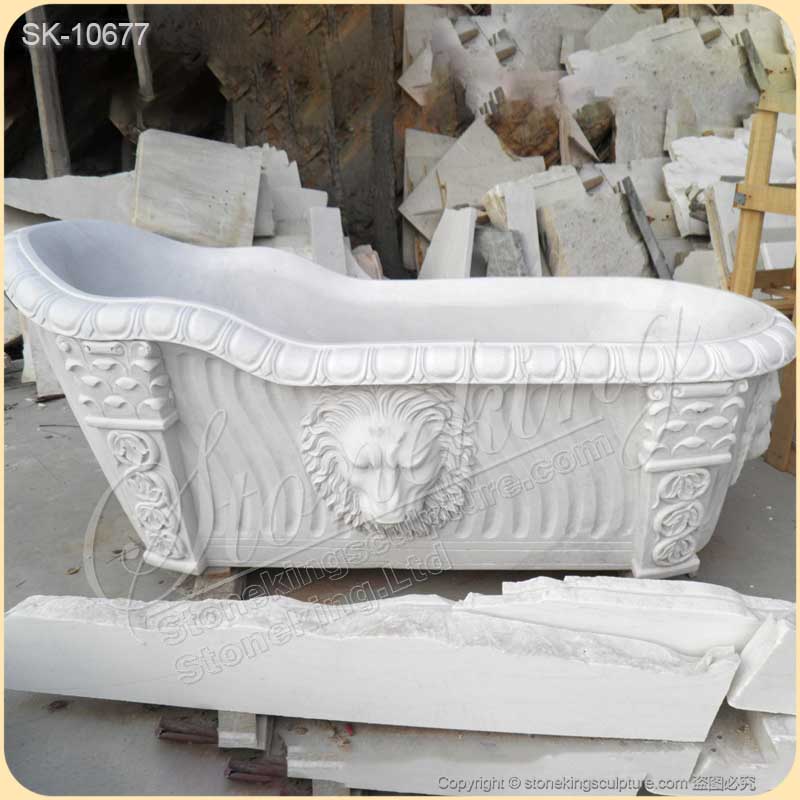
Different stains require different treatments. For example, oil-based stains may need a specific solvent, while mineral deposits might be removed with a gentle scrub and a bit of baking soda. For stubborn stains, make a paste of baking soda and water, then apply it to the stained area and let it sit for a few minutes, gently scrub with a soft cloth and rinse well. For mineral deposits or tough stains, consider using a cleaner specifically designed for stone surfaces. Always test any product in a small, inconspicuous area first.
Stone bathtubs should be sealed regularly to prevent stains and water absorption. Use a high-quality sealer and check the sealant by sprinkling water on the surface. After bathing, wipe down the sides of the tub and ensure proper drainage. If you notice any chips or cracks in the stone bathtub, address the promptly to prevent further damage. Place soft bath mats or soft towels inside and around the tub to avoid scratching and to prevent slipping.
Are Stone Bathtubs Durable?
Stone bathtubs are highly regarded for their luxurious appearance and robust construction. Known for their long-lasting durability, these tubs bring a natural and timeless aesthetic to bathrooms while offering a strong an reliable fixture for daily use. Unlike acrylic or fiberglass bathtubs, which may flex or crack under pressure, stone tubs maintain their shape and integrity over time.
The inherent toughness of natural stone means these bathtubs are resistant to cracks, chips and general wear and tear, which makes them last for decades. And they can endure heavy use without showing signs of deterioration. Because of the density of stone, it takes longer for the tub to lose heat. This will add to the perceived durability of the tub, as there is no risk of the material warping or degrading under prolonged exposure to warm water.
The durability of a stone bathtub also comes with a significant weight. These tubs are extremely heavy, especially when filled with water. While this weight adds to the sense of durability and stability, it can complicate the installation process. With proper care and maintenance, stone bathtubs can last a lifetime.
Granite is known for its exceptional strength and density, so granite bathtubs are incredibly durable.
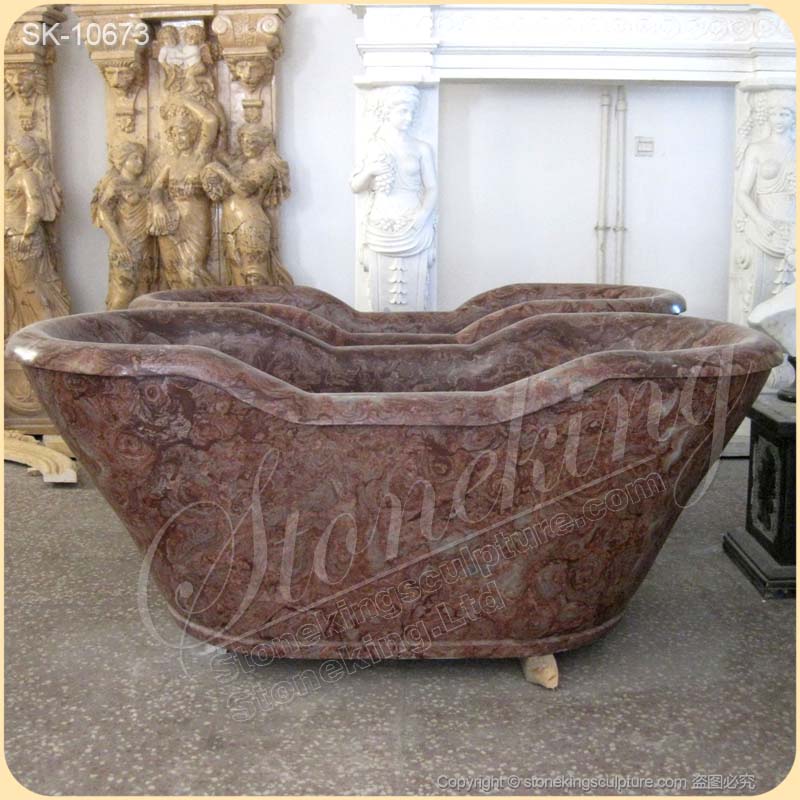
They resist chips, cracks and scratches more effectively than most other stones. Granite is less porous than marble, making it more resistant to moisture and stains. Marble is a strong, long-lasting material that can withstand regular use. Its durability lies in its resistance to cracking and breaking under normal use. With proper care, a marble bathtub can last for decades. Onyx bathtubs are more fragile compared to granite or marble, making them more prone to scratches, chips and cracks. They require regular maintenance to prevent water absorption and staining, but they can still last a long time with proper care.
Travertine is a sturdy material that can last for many years with proper care, but it is more porous than granite and marble. Regular sealing is necessary to protect the stone from moisture, stains and soap scum buildup. If properly maintained and sealed, a travertine bathtub can withstand regular use and remain in good condition. Limestone is a relatively soft stone compared to other like granite or marble, but it is still sturdy and long-lasting. Limestone is porous, which means it can absorb water, oils and other liquids. To enhance durability and protect it from staining or water damage, limestone bathtubs need to be proper sealed. With proper care, a limestone bathtub can last for many years.
What Types of Stone are Commonly Used for Bathtubs?
Marble
Marble is a classic choice for bathtubs, renowned for its luxurious appearance and smooth texture. The luxurious bathtubs come in various colors and veining patters, making each tub unique. Marble is not only visually stunning but also retains heat well, proving a warm and relaxing soak. However, marble is porous and can stain easily, so regular sealing and careful cleaning are essential.
Granite
Granite is durable and highly resistant to scratching, cracking and chipping, making it an excellent option for bathtubs. It offers a robust surface that can withstand the rigors of daily use, making it a practical choice for a long-lasting tub. Granite is available in a wide range of colors and patterns, allowing homeowners to select a style that fits their decor. While it can be expensive, its longevity makes the granite elegant bath a worthwhile investment.
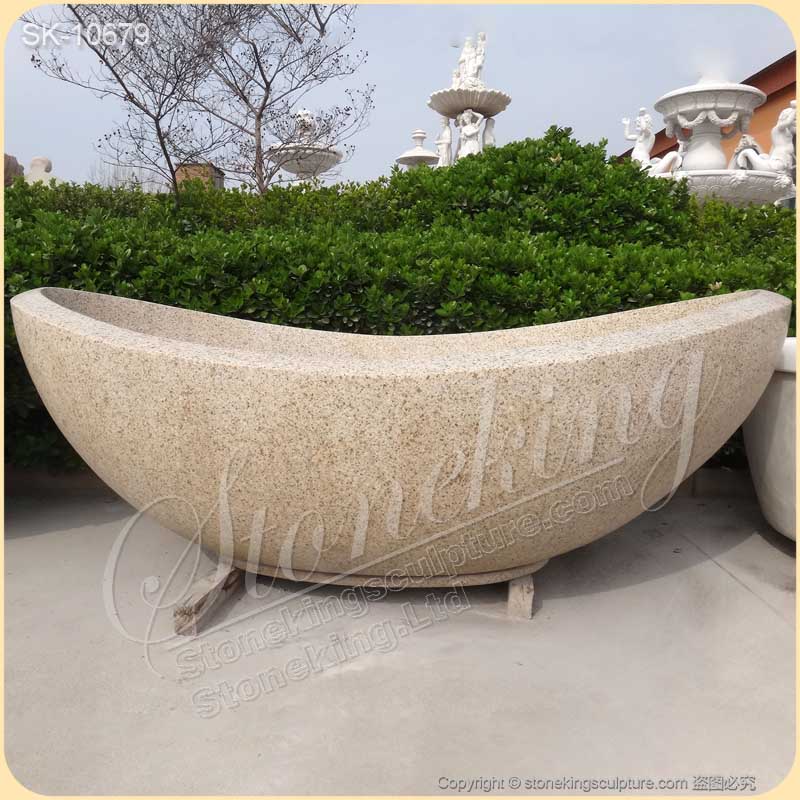
Sandstone
Sandstone is also used in some bathtubs, providing a unique texture and appearance. Sandstone has a distinct appearance with its earthy tones, layered textures and grainy patterns, giving the bathtub a rustic and organic look. Sandstone is relatively hard and durable, making it suitable for bathtubs. However, it is softer compared to materials like granite, so it might wear down slightly over time, but with proper care, it can last for decades. The natural texture of sandstone provides a slightly rough surface, making it less slippery when wet compared to polished surfaces like marble or porcelain.
Limestone
Limestone offers a rustic and natural aesthetic, often featuring a more matte finish compared to other stones. Its soft texture makes it comfortable to touch, but it is more susceptible to scratches and stains. Regular sealing is needed for maintaining limestone's appearance and protecting it from water damage.
Travertine
Travertine is a types of limestone that forms around mineral springs. It has a unique texture, often characterized by small holes and pits, which can give it a distinctive look. It is available in earthy tones and has warm feel. This stone is also durable but needs sealing to prevent water damage due to its porous nature.
Onyx
Onyx is a strikingly beautiful stone, known for its dramatic color patterns and translucence. It has a polished finish that enhances its visual appeal, and onyx bathtubs are often used a statement piece due to its unique and luxurious appearance. But, onyx is softer and more fragile than other stones, making it less suitable for high-use areas. Regular maintenance and sealing are vital to protect it from scratches and moisture.
Can a Stone Bathtub be Installed in Any Bathroom?
Weight and Structural Support
One of the primary concerns when installing a stone bathtub is its weight. Stone bathtubs are significantly heavier than traditional acrylic or fiberglass models, which means that your bathroom floor must be able to support the additional load. In some cases, you may need to reinforce the flooring or even consult with a structural engineer to assess whether the existing floor can handle with the weight of the bathtub when filled with water. Reinforcements may be required in older homes or spaces with less durable flooring.
Space Requirements
Stone bathtubs come in various sizes and shapes, so it is essential to assess the available space in your bathroom. Sufficient space in the bathroom is necessary to accommodate a stone bathtub comfortably. Measure the area where you plan to install the tub, ensuring there is enough room for the bathtub itself and adequate clearance for entry and exit. Bathrooms with limited space may pose a challenge and might not support the installation of such a substantial fixture. Additionally, consider the overall layout of the bathroom, including nearby fixtures like sinks and toilets.
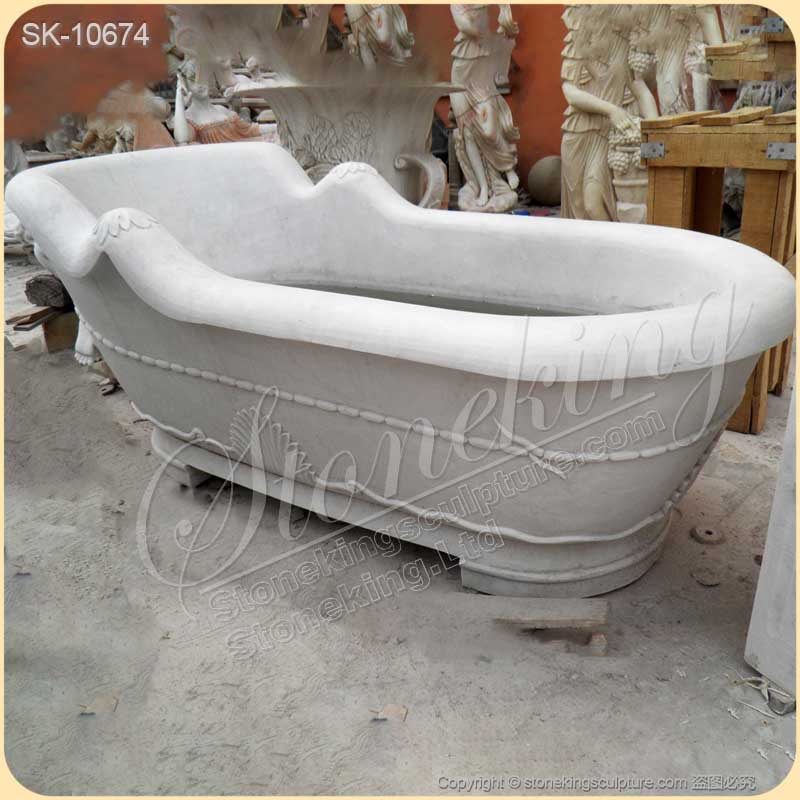
Plumbing Considerations
The installation of a stone bathtub may require adjustments to your existing plumbing. Ensure that the water supply and drainage systems can accommodate the new tub. Depending on the type of stone and design of the tub, consult a plumber to ensure proper drainage and water supply. Additionally, consider the placement of the faucet and any additional features, like jets or overflow drains.
Style and Design Compatibility
Stone bathtubs come in various designs and finishes, allowing you to choose one that complements your existing bathroom decor. Consider the color, texture and style of your current fixtures and furnishing to ensure a harmonious look. Whether you room is modern, rustic, or traditional, select a stone type and finish that enhances the existing decor. A well-chosen stone tub can become a stunning focal point in your bathroom.
Maintenance and Care
Stone bathtubs require specific care to maintain their beauty and longevity. Depending on the type of stone, you might need to seal the surface regularly to prevent staining and damage. Be prepared for the upkeep required to keep the bathtub in optimal condition.
Budget Considerations
Stone bathtubs can be a significant investment, not only in terms of the tub itself but also related to installation costs. Be sure to budget for not only the tub itself but also any necessary renovations to your bathroom, including adjustments and floor reinforcement. Comparing different types of stone and styles can help you find a solution that fits within your financial plan.
What Styles and Designs are Available for Stone Bathtubs?
Freestanding Stone Bathtubs
Freestanding stone bathtubs are a highly popular style due to their sculptural presence. Placed independently of walls, these tubs become the centerpiece of a bathroom. Carved from large stone blocks, they exude elegance and grandeur, typically requiring a spacious bathroom to complement their size. Common shapes include oval soaking bath, rectangular bath, square tubs, round shapes, slipper and boat-shaped tubs, and organic forms.
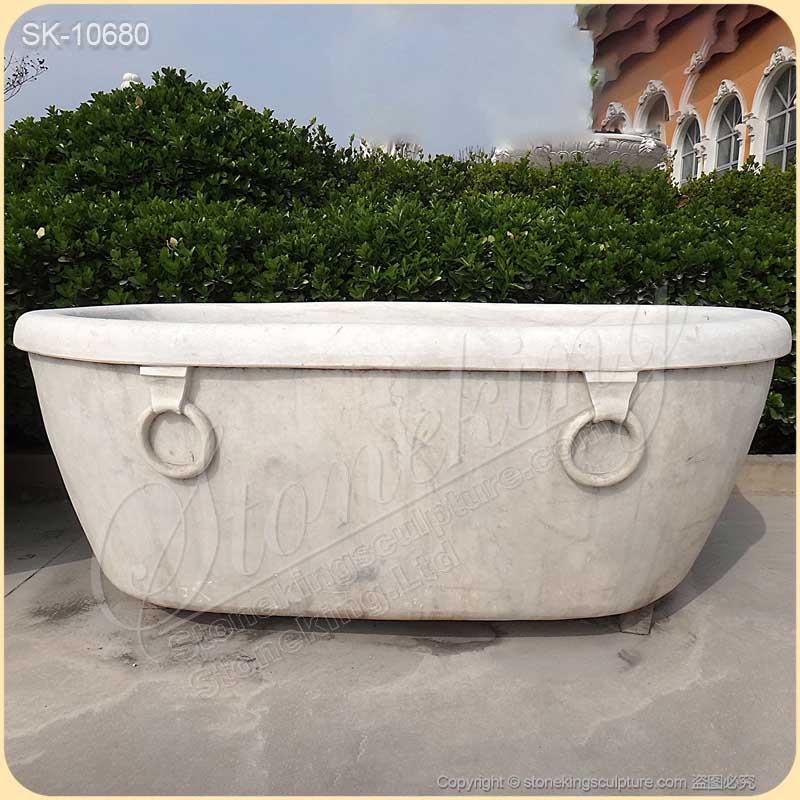
Modern Minimalist Stone Bathtubs
For those who favor clean lines and simple aesthetics, modern minimalist stone bathtubs offer a sleek and streamlined look. These tubs often feature geometric shapes, with sharp angles or smooth, continuous curves. Polished marble and limestone are often chosen for their subtle elegance, contributing to a contemporary vibe. Modern immersion tub emphasizes functionality and form, and they complement modern or industrial aesthetics, particularly in neutral tones like white, gray or black stone.
Japanese-Style Stone Soaking Tubs
Inspired by traditional Japanese "ofuro" baths, these stone tubs are often deeper and shorter than conventional tubs. They are designed for full immersion and relaxation, promoting a meditative bathing experience. These tubs usually feature a round or square shape and can be made from smooth stone such as granite, bringing a sense of serenity and tranquility into the space. They are perfect for smaller bathrooms or spaces emphasizing minimalist or Zen-inspired decor.
Clawfoot Stone Bathtubs
Clawfoot bathtubs are luxurious, freestanding bathtubs characterized by their elevated design, supported by four decorative feet (often resembling animal claws). The classic clawfoot design evokes a vintage or antique aesthetic, while the use of stone elevates it to a more modern, luxurious standard. The claw fee themselves can be intricately designed in various styles, often polished to match the overall aesthetic of the tub. The lion claw tub type is a popular one among them.
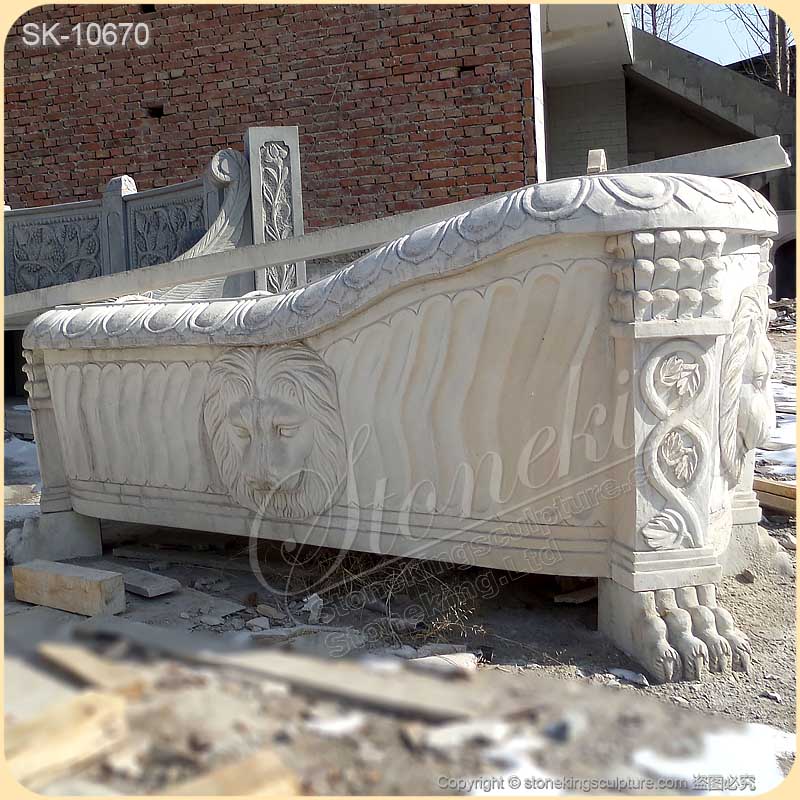
Alcove Stone Bathtubs
Alcove stone bathtubs fits into a three-wall enclosure. These tubs are practical for bathrooms where space is a concern, as they utilize the walls to create a compact soaking area. Typically, alcove tubs have more rectangular shape.
Drop-in Stone Bathtubs
Drop-in stone bathtubs are designed to be installed into a customized deck or surround, with only the rim of the tub visible. This style can be integrated into a variety of bathroom layouts and provides more flexibility in blending with other elements of the design. The stone interior remains the main attraction, providing a serene, earthy soaking space. Drop-in tubs are a popular choice for larger bathrooms and are often used to create built-in spa or jacuzzi areas.
Custom Sculptural Stone Bathtubs
For those looking for something truly unique, custom sculptural stone bathtubs offer the ultimate in personalization. These tubs are designed and carved to meet specific aesthetic preferences, often becoming works of art in their own right. Shapes and styles can vary widely, from abstract forms to nature-inspired motifs. These tubs, like lion head bathub, are highly artistic and often serve as the defining element of the bathroom, ideal for luxury spaces.
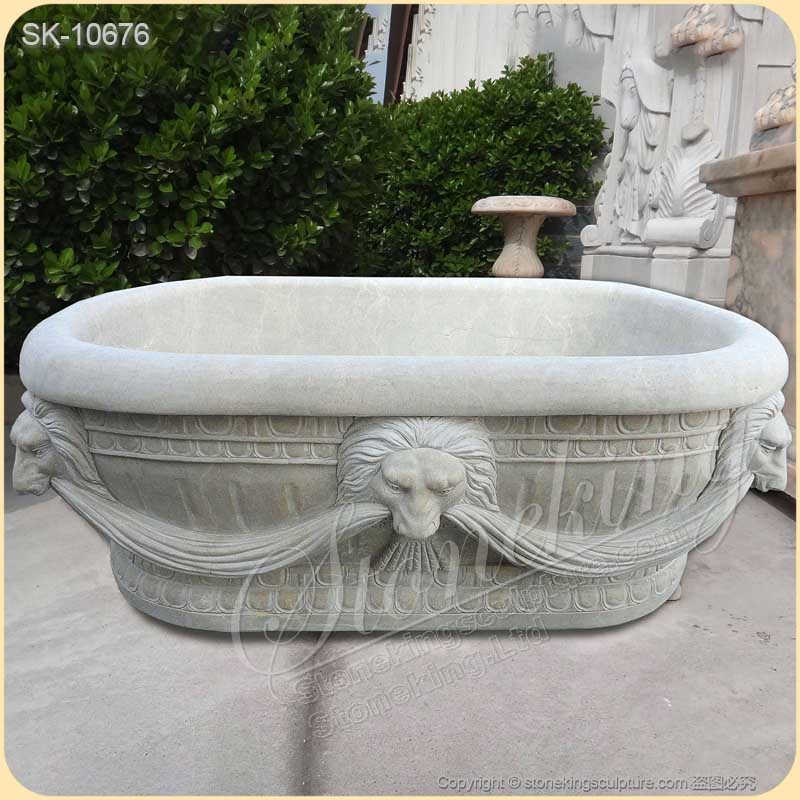
Natural Stone Bathtubs
Natural stone bathtubs, often referred to as boulder tubs, are created from large, rough stones that are hollowed out to form a tub. These tubs retain much of the stone's natural texture and appearance, making each one unique. They often have an organic shape, with rough exteriors that contrast with the smooth, polished interior for comfort. Natural stone tubs bring a raw, earthy element to the bathroom, perfect for rustic, bohemian, or nature-inspired designs.
Do Stone Bathtubs Retain Heat Better than Other Materials?
Stone is a dense, natural material, and its heat retention ability is a key characteristic. Stone bathtubs are known for their exceptional heat retention properties, and the density of natural stone allows it to absorb and retain heat for longer periods compared to lighter materials. Thermal mass refers to the material's ability to absorb, store and gradually release het. Because stone has a higher thermal mass than many synthetic materials, it takes longer to heat up, but once it does, it retains warmth for an extended period. This feature makes stone bathtubs ideal for maintaining a comfortable bathing temperature, especially during longer soaks.
Acrylic bathtubs are lightweight, inexpensive an easy to install, but they do not retain heat as well as stone. They tend to lose heat relatively quickly because they are less dense than stone. While they heat up faster, the warmth dissipates faster as well, which can result in a less enjoyable bathing experience.
Fiberglass bathtubs are even less effective at retaining heat than acrylic. While they are affordable and light weight, their thin construction allows heat to escape quickly, making them a poor choice for those who value heat retention. The lightweight nature of fiberglass means there is less material to absorb and hold heat, resulting in a shorter, cooler bath experience.
Cast iron bathtubs, with their enamel coating, are incredibly effective at holding heat because of the dense metal beneath the surface. They are heavier and can hold heat for an extended period, much like stone. Steel bathtubs do not retain heat as well. Though they warm up quickly, they also cool down quickly, similar to acrylic and fiberglass bathtubs. The thin metal of steel allow heat to dissipate faster than in materials like stone or cast iron.
Can Stone Bathtubs be Customized?
Stone bathtubs can be carved from various types of stone, each offering distinct characteristics. Marble is known for its elegant veining and smooth finish, and will provide a classic look. Granite is extremely durable and resistant to scratches, with a range of colors and patterns. Onyx provides a unique look with stunning colors, travertine has a unique texture and is often used for rustic aesthetic, and limestone has a natural look with earthy tones and textures. The type of the stone could be bespoke to suit your preference and bathroom surroundings.
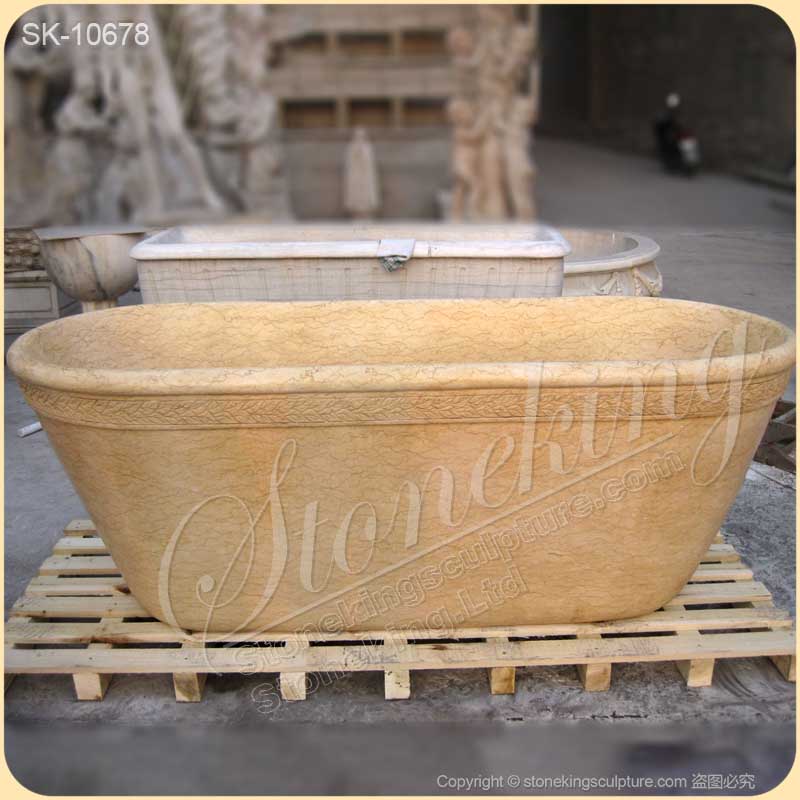
Stone bathtubs come in various shapes and sizes, allowing you to choose one that fits your bathroom layout. Common shapes include free-standing tubs that could be placed anywhere in the bathroom, offering a statement piece and flexibility in design. Rectangular bathtubs is sleek and modern, fitting well in contemporary bathroom, and they can be simple or have more elaborate edges. Oval bathtubs offer a softer look while providing ample space for soaking. Circular or round bathtubs can serve as a stunning centerpiece and are often more spacious inside, making them great for relaxation. Square designs offer a modern, minimalist aesthetic. Organic bathtubs mimic natural shapes, resembling rocks or smooth pebbles, often blending seamlessly natural decor. Custom designs are made to meet the specific spaces, allowing for unique configurations that suit individual preferences.
The finish of the stone bathtub could be customized, and the finish will affect its look and feel. Options include polished surface that will provide a shiny, reflective surface, honed surface that will offer a matte finish, textured finished that can add a rustic or artisanal feel. Finally, adding personal touches can elevate your stone bathtub experience, such as the integrated shelving, drain system or heating system to suit practical needs.
How do Stone Bathtubs Compare to Other Materials?
Aesthetic Appeal
Stone bathtubs bring a natural, organic feel to a bathroom. Each piece is unique, showcasing the natural variations in the stone, which can create a striking focal point in modern or traditional settings. In contrast, acrylic and fiberglass tubs often have a more uniform appearance and can lack the richness of natural materials. Cast iron and porcelain also have classic appeal but may not provide same warmth and texture as stone.
Durability and Maintenance
Stone bathtubs are incredibly durable and can last a lifetime with proper care. They are resistant to chipping and scratching, making them ideal for long-term use. However, they may require periodic sealing to prevent staining and water absorption. Acrylic bathtubs are resistant to chipping and cracking, but can scratch easily. They may discolor over time and typically require replacement after several years. Fiberglass bathtubs are the least durable of the materials compared. They can stain and scratch over time, leading to discoloration. While easy to clean, they may require replacement sooner than stone or cast iron. Cast iron bathtubs are exceptionally durable and resistant to wear. Its enamel coating can chip, but the underlying cast iron remains intact. Maintenance involves regular cleaning to prevent rusting and chipping. Porcelain bathtubs are durable but can chip or crack if subjected to heavy impact, and they also need careful cleaning to prevent dulling.
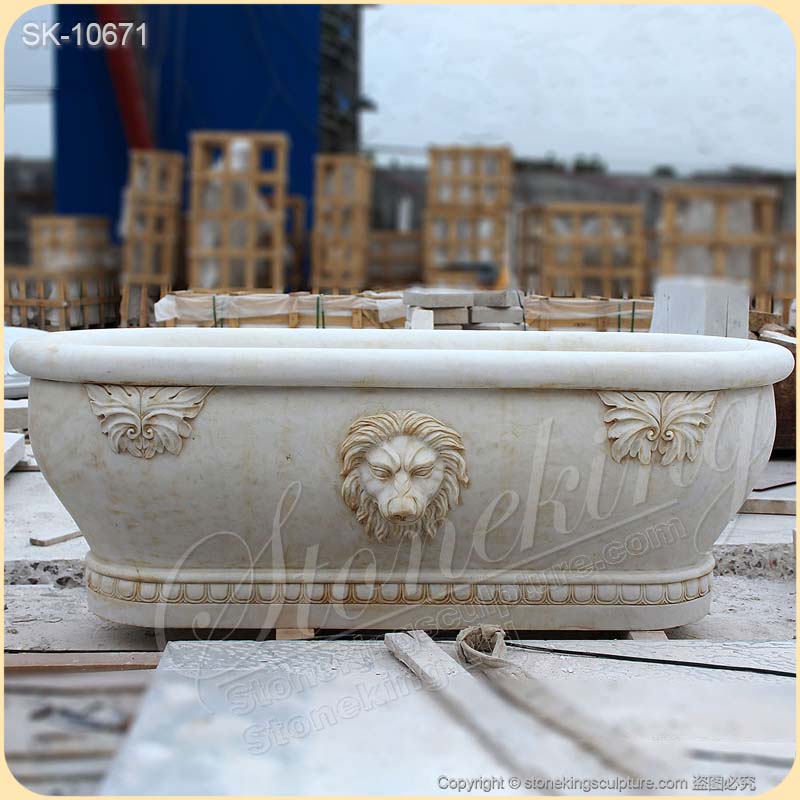
Heat Retention
One of the significant advantages of stone bathtubs is their superior heat retention. Stone absorbs and retains heat well, providing a warm and soothing bathing experience. Acrylic and fiberglass bathtubs, on the other hand, tend to cool down quickly, which might require frequent reheating of the water. Cast iron and porcelain tubs are excellent at retaining heat, providing a long-lasting warm bath.
Weight and Installation
Stone bathtubs are heavier than most other materials, requiring reinforced flooring and careful installation. Acrylic and fiberglass tubs are much lighter and easier to install, making them a more DIY-friendly option. Cast iron tubs are also heavy, but not as much as solid stone, They may also require reinforcement. Porcelain tubs, while not as heavy as stone, still require careful installation.
Price Range
Stone bathtubs tend to be on the higher end of the price spectrum due to the cost of materials and the craftsmanship involved in their production. Acrylic and fiberglass tubs are generally more affordable and widely available, making them popular choices for budget-conscious homeowners. Cast iron and porcelain bathtubs fall somewhere in the middle, with prices varying based on design and underlying material.
Are Stone Bathtubs Environmentally Friendly?
Stone is a natural material, it is non-toxic and biodegradable, meaning it won't contribute to long-term waste in the environment. One of the key advantages of stone bathtubs is their durability. Unlike acrylic or fiberglass bathtubs, which may crack or wear over tie, stone bathtubs are highly durable and resistant to damage. With proper care, they can last a lifetime or even longer, meaning that fewer resources are used to replace or repair the bathtub, thus reducing the environmental impact.
When a stone bathtub reaches the end of its lifecycle, it can also be repurposed or recycled into other building materials, contributing to a circular economy and reducing waste. Additionally, stone bathtubs typically do not contain harmful chemicals or synthetic materials, making them more eco-friendlily when disposed of.
Stone bathtubs are relatively low maintenance, requiring eco-friendly, pH-balanced cleaners, which have a lower environmental impact, making the long-term maintenance of a stone bathtub more sustainable. Additionally, stone's heat-retention properties can contribute to energy savings in the long term.
The dimensions of the marble freestanding bathtub could be customized to fit your bathroom space and personal comfort. Whether you prefer a classic clawfoot tub, a modern design or other types, we could like to carve to your specifications. Incorporate features like soap dishes, seating areas, or some meaning design to create a more personalized and unique design. Our expert design team can make detailed drawing if you have any pictures or drafts and ODM services are offered.







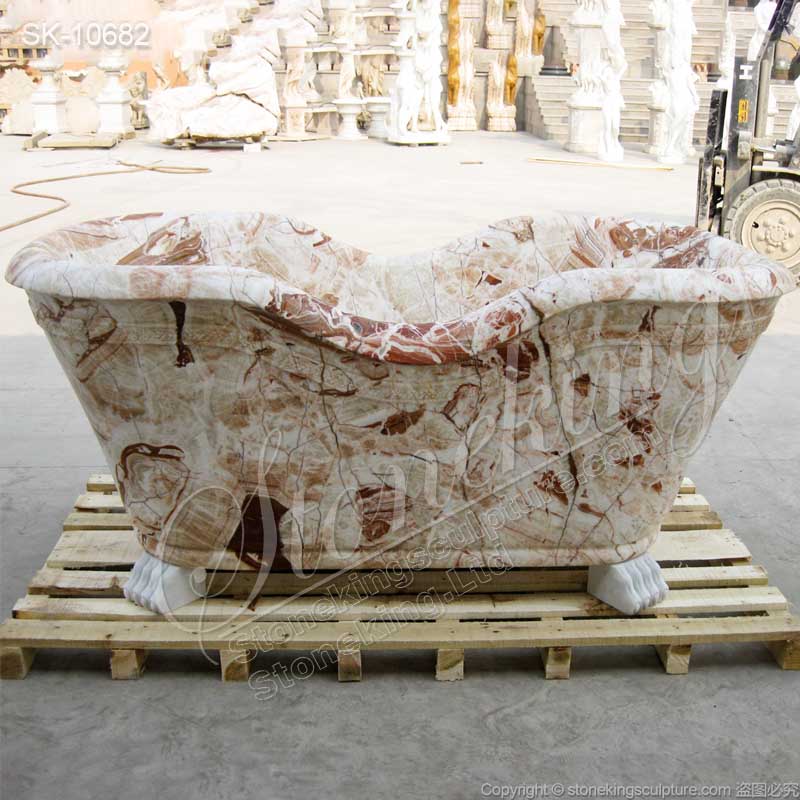
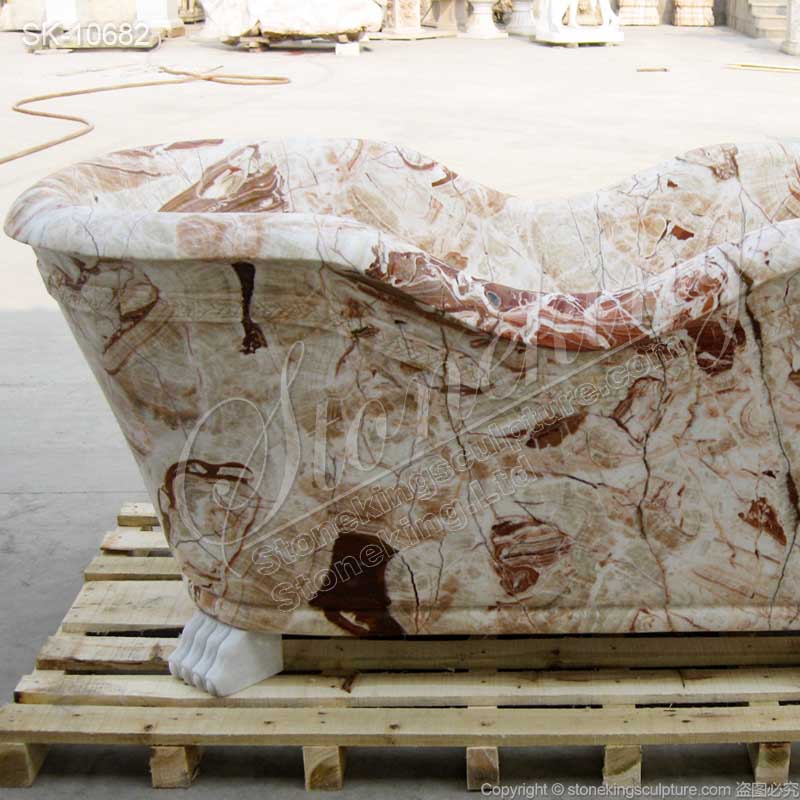
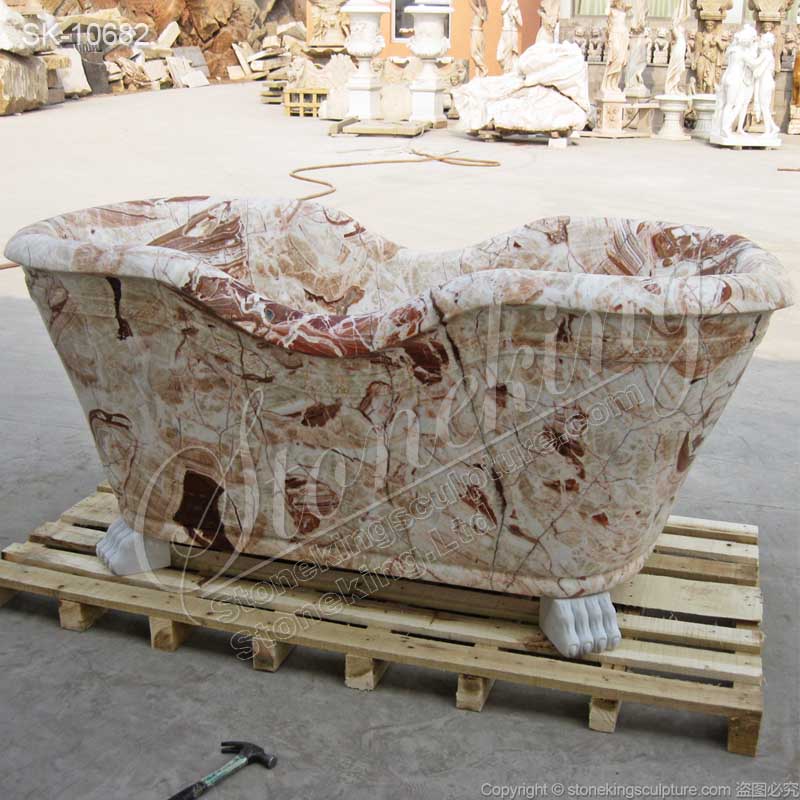
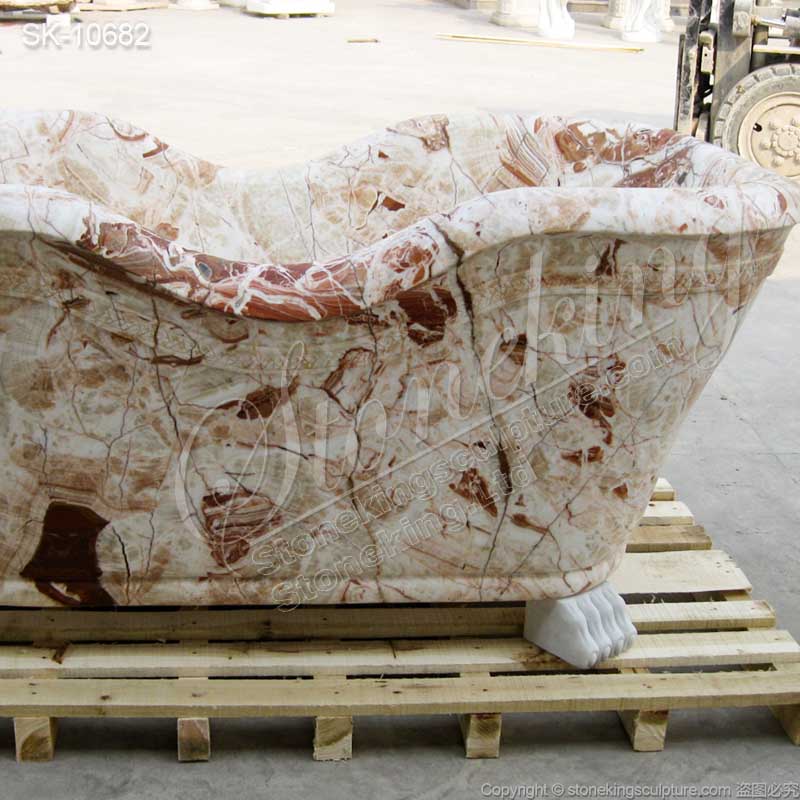
 Add to Inquiry List
Add to Inquiry List 